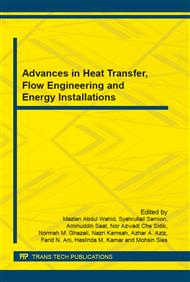p.11
p.16
p.23
p.29
p.34
p.42
p.46
p.58
p.63
An Analytical Convergence Study of the Forced Air Cooling in Electronic Packaging
Abstract:
A forced air thermal cooling model has been developed by using Ansys software, to study at each step of the input power, what will be the corresponding junction temperature Few approaches were used to ensure the accuracy of the thermal simulation method, ranging from the minimum number of simulation iterations required in the finite element analysis, to the residuals target in terms of the momentum, continuity and energy equations, the objective is to ensure the simulations are converged and provide the reasonable results, which is also an indication of how the partial equations have successfully been solved with analytic method. The thermal resistance network in the model has also been established, mainly to understand the next level details in this thermal model by analyzing the correlation between the air flow and the thermal resistance at each junction, and also to understand the effect of the air flow with respect to the total thermal resistance. The thermal analytic model that built has proven to be healthy and it requires 200 iterations to achieve steady state with the reasonable temperature output, and there is no convergence issue in which the continuity, momentum and energy graphs showed the healthy trend, it achieved 10-7 for continuity, energy and momentum equations. it shows that when the air flow reduces the overall thermal resistance increases, in other word, reducing the air flow will increase the thermal resistance
Info:
Periodical:
Pages:
34-41
Citation:
Online since:
January 2016
Authors:
Price:
Сopyright:
© 2016 Trans Tech Publications Ltd. All Rights Reserved
Share:
Citation:


